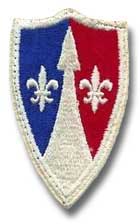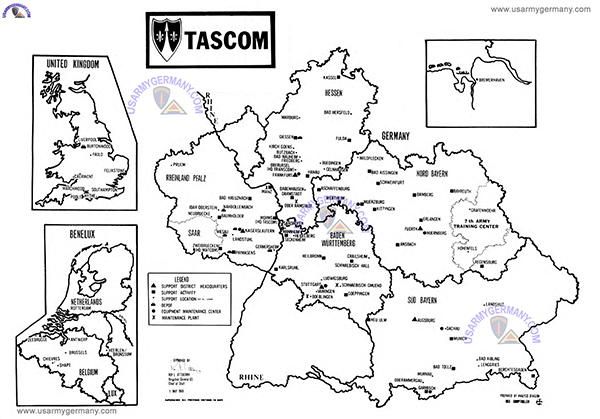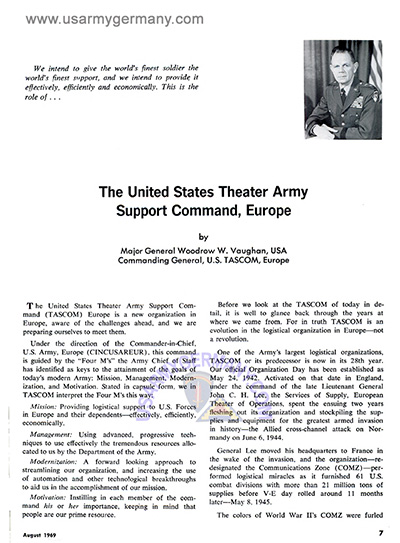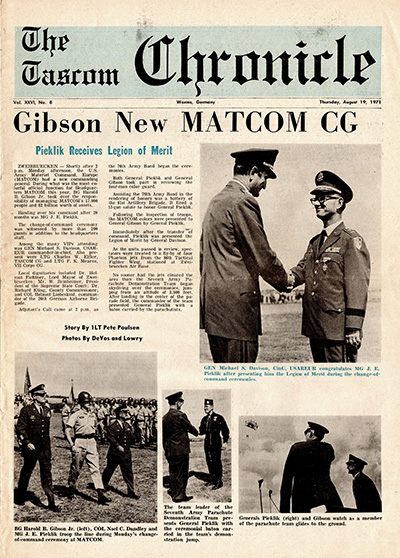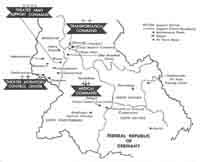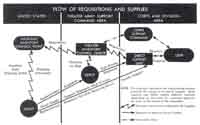| If you do
NOT see the Table of Contents frame to the left of this page, then
Click here to open 'USArmyGermany' frameset |
||||||||||||
|
Theater
Army Support Command, Europe |
||||||||||||
|
|
||||||||||||
|
||||||||||||
|
|
||||||||||||
| TASCOMEUR History | ||||||||||||
| 1951 - 1969 | ||||||||||||
| (Source: Short History of TASCOM, 1969) | ||||||||||||
| SHORT HISTORY
OF TASCOM By a recommendation from the Department of the Army, the present United States Theater Army Support Command, Europe -- an extension as of 25 April 1969 of the United States Army Communications Zone, Europe -- has in recent years celebrated its anniversaries as of 24 May 1942. However, it was officially established on 15 July 1951 as a major subordinate command of the European Command (hence its designation EUCOM COMZ) with headquarters at Coligny Caserne, Orleans, France; a Base Section (BASEC) with headquarters at La Rochelle, France; and an Advance Section (ADSEC) with headquarters at Verdun, France. COMZ's main ports lay in the Bordeaux-La Pallice area and its depots were scattered across France from those ports to the (former) US Zone of Germany. Brigadier General Mason J. Young was the first commanding officer. EUCOM COMZ was created because of the vulnerability of Bremerhaven (main supply port) and the Line of Communications (LOC) through Germany, and also because of new requirements under Supreme Headquarters, Allied Powers, Europe (SHAPE). The establishment of the LOC through France was made possible only by an arrangement signed by France and the United States on 6 November 1950. On 1 August 1951 (sic), EUCOM COMZ was redesignated United States Army, Europe Communications Zone (USAREUR COMZ) as a result of a joint US European Command (USEUCOM) being organized and the former EUCOM being renamed United States Army, Europe (USAREUR). TASCOM, then, inherited the remarkable achievements of the World War II Services of Supply and, much later, COMZ. On 24 May 1942, the Services of Supply, ETO was established in England with Lieutenant General John G.H. Lee as its first commanding general. Two years of build-up and stockpiling of supplies and equipment culminated in that command's being redesignated in May 1944 as the Communications Zone, ETO. General Lee moved his headquarters to France soon after D-Day -- 6 June 1944 -- and during the ensuing 11 months enormous logistical operations took place. The World War II infantry soldier was supplied and re-supplied at a rate and with an efficiency never before attained. By the time V-E Day rolled around on 8 May 1945, the TASCOM of that war had furnished 61 combat divisions of the Allied Expeditionary Force, commanded by General of the Army Dwight D. Eisenhower, with more than 21 million tons of vital supplies. And when the colors were furled in January 1946, the logistical feats of World War II had attained very nearly the status of legend. Allied battle commanders were unanimous in their praise of the magnitude, efficiency, and ingenuity of the American logistical system. Less than three years later, the Communist blockade of Berlin during 1948-1949 made all too clear the necessity for a new line of communications. Events moved rapidly; the North Atlantic Treaty Organization (NATO) was formed; Allied Command, Europe was established; and a greatly augmented line of communications was needed to supply the US Forces committed to the alliance and to maintain them in a state of combat readiness on the continent of Europe. Only five days after the conclusion on 6 November 1950 of the agreement already mentioned between the Governments of France and the United States, about 1,000 US technical (service) troops moved into France with 300 trucks and trailers loaded with the necessary equipment to set up shop. By 11 November 1950, the first supply ships were unloading at Bordeaux, and COMZ, though not yet established, was in business. It was to remain in France until 1967. From a small nucleus, COMZ expanded -- improvising, experimenting, building, improving -- until it became a vast network of ports, depots, maintenance plants, and administrative and communications facilities. Crisis and potential strife arose but COMZ never broke its stride as it provided the necessary supplies to support US Forces during such tense days as those of the Lebanon Crisis in 1958 and the build-up of US Forces in Europe following the erection of the infamous Berlin Wall in 1961. Then, in the spring of 1966, came the decision by the French Government that all Allied Forces must be out of that country by 1 April 1967. For COMZ, this meant moving about 70,000 people and 700,000 tons of supplies out of France in slightly more than 11 months. To the amazement of nearly everyone, the task was done. On 27 February 1967, COMZ (Forward) was established here in Worms. Three months later -- on 1 July 1967 -- the mission and responsibilities of COMZ were significantly enlarged when it absorbed the former US Army Area Command. Although a 'shakedown cruise' of three months was authorized, most of the staff elements of the two commands were meshed and in smooth working order well before the 30 September deadline for the merger. The following year, 1968, also brought changes. Operation CORD -- an acronym for 'COMZ Realignment of Districts' -- merged the former Area Command's ten districts into five US Forces Support Districts, steamlining area supporting functions. (See Area Command for more details) A sixth support district was later added. On 25 April 1969, the command was redesignated as the United States Theater Army Support Command, Europe. Shortly before the coming closeout and merger into Headquarters, USAREUR, TASCOM's chief subordinate commands were: |
||||||||||||
|
||||||||||||
| TASCOM has been the Army's largest logistical organization. Its 'family' of more than 69,000 people -- military, US and local national civilians -- have carried on the tradition of service handed down to them by their predecessors, supporting nearly 400,000 Americans in Europe, Asia Minor, and Africa. | ||||||||||||
(Source: STARS & STRIPES, April 28, 1969) |
||||||||||||
Com Z is now TASCOM In the ongoing USAREUR program to streamline the command and logistical structure within the Theater, the new TASCOM headquarters announced the redesignation of one of its major subordinate commands: the former Com Z Supply and Maintenance Agency is now known as US Army Materiel Command Europe. The other major subordinate command of TASCOM is US Army Transportation Command, Europe. TASCOM is commanded by Maj Gen Woodrow W. Vaughan. Although the command's activities stretch from Portugal and Italy to Great Britain and Denmark, most of the facilities are located in Germany. MATCOM, located in Zweibrücken, is commanded by Brig Gen Edwin I. Donley. The command is responsible for wholesale supply and depot level maintenance activities, processing between 180,000 - 200,000 supply and maintenance requests a month. In the command's depots there are more than 2 million tons of items on hand. TRANSCOM, stationed at Oberursel, is commanded by Col Robert W. Larson. The command is responsible for managing all US Army sponsored transportation activities in central Europe and providing transportation management support for other US forces activities within the Theater. TRANSCOM's major subordinate units are: |
||||||||||||
| Additional issues of the TASCOM Chronicle from 1970-1971 are available on line on Dropbox. (These issues have been made available thanks to the efforts of several members of the "Zweibrücken and Kreuzberg Kaserne" Facebook Group). If you have additional copies of the TASCOM Chronicle that are not yet in our online collection, we would be interested in hearing from you -- please contact the websmaster -- see email link at top of page -- or the FB Group. | ||||||||||||
(Source: Email from Bill Terry, 627th Supply Co; HHC, 3rd Logistical Command; and HQ USATASCOMEUR, 1968-71) |
||||||||||||
In February 1968, while at Classroom Support Branch, Engineer OCS, Fort Belvior, VA, I received orders to 627th Supply Company, 115th S&S Bn at Spinelli Barracks in Mannheim Germany. After arriving there I found out the requisition was supposed to be for MOS 76P (Stock Control and Accounting) but a clerical error requisitioned 20 something 76Y (Unit Supply Specialist). I was assigned as a repair parts warehouse supervisor until I had a chance to go to Hq/Hq Company, 3rd Log Command in Worms, where I heard there was a supply sergeant vacancy. As I was experienced, needed immediately and was mal-assigned I got a transfer in January 1969. In April 1969 I requested a transfer to HQ USATASCOMEUR to work for the DCS for Supply and Maintenance. I just went from one building to another. We were living in Mannheim in Benjamin Franklin Village and as my wife was working for the commander HQ US Army Augmentation Group (Reforger), it was decided I would commute from Mannheim to Worms In my office was a LTC, a major, a SFC and me, an E5. We were supposed to have a captain but Vietnam was getting more personnel than Germany. So I was assigned an O3 job as action officer on High Priority Requisition Abuse (Like typewriter ribbons as an A1 priority which was reserved for combat vehicles), Damaged Container Shipments (like flour and kerosene getting mixed up in shipment) and Reclaiming Serviceable Equipment from Property Disposal yards (like new boots being PDO'd for lack of strings). If severe infractions were found I was expected to write General level letters to commanders requiring them to RBI (reply by endorsement) with an explanation why it happened and what had or was being done to correct the problem. Of course these letters were "staffed" and 3 versions were sent to the General, good, better, and best. I will never forget the CG, Lt General Charles Eifler. (http://www.arlingtoncemetery.net/cweifler.htm) The advent of computers required that logistics be computerized. One day I was told to attend a meeting about computerizing the Property Books and stock record accounts in the five support districts, including Burtonwood in England and NATO/SHAPE in Belgium. I did and found out a few days later, as we still didn't have a captain, I was to be the functional "expert" working with 3 data systems programmers, to develop programs. I told them what we needed and they did the rest. Remember this was in the day of computers with punch cards and spaghetti boards. This resulted in some great TDY's for SP6 Carruthers and myself, including Burtonwood, where his LT and 2 others felt they had to go. Burtonwood is near Manchester and Liverpool and both had good nightlife scenes (remember the Beatles came from that area). After we did our work, I found out the LT had come because he wanted us to take a layover in London so he could see the musical "Hair" We were charged a days leave because they said London wasn't on our way back. During this time I was promoted to E6. When we went to the Support Districts to change them over and train them in the automated systems, the majors in charge were not very accommodating. We understood as they too were short handed and had to run parallel manual and automated systems for 3-4 months until they got acquainted with the system and had the bugs worked out. Several refused us outright, so we went back to Worms and we reported directly to a BG, who told us to be ready to go back Monday following. When we did we were treated like VIPs. I think a phone call or two was made. In January 1971 I was transferred back to CONUS to 1st Instructor Company, Quartermaster School Fort Lee VA. |
||||||||||||
(Source: STARS & STRIPES, June 28, 1969) |
||||||||||||
On or around 1 July 1969, TASCOM assumed the responsibilitries for direct support of combat units west of the Rhine River. |
||||||||||||
|
|
||||||||||||
| Merger with HQ USAREUR | ||||||||||||
| Supporting the troops from D-Day to to-day, By M.S. Lindner, The TASCOM Chronicle, June 28 1974 | ||||||||||||
|
EXCERPT
WORMS - For all intents and purposes, TASCOM will be going "out of business" on July 1, 1974. On that day, it will lose the remainder of its major subordinate commands as it continues to move toward the finalization of its merger with USAREUR. That merger is scheduled to be completed Sept. 30. Though there still will be a TASCOM Hqs. from July 1 to Sept 30, it will largely be in a phase-out status as it continues to assist with the merger while moving toward "zero strength." The headquarters will not actually be inactivated but, instead, will become part of USAREUR Hqs. in a "zero strength" posture. This is to permit its reconstitution in the event of an emergency. Streamlining The merger of TASCOM with USAREUR is designed to bring about "a stronger combat-to-support ratio and the streamlining of headquarters functions within the command," according to USAREUR officials. To accomplish this, missions and functions which have been performed by TASCOM are being taken over by other commands. Transfer of functions actually began earlier in the year. Among the first TASCOM major subordinate commands to be switched to direct USAREUR control were the Postal Group, Europe, on Jan 1; the 15th Military Police Brigade and 59th Ordnance Group on April 1, and the USAREUR Recreation Services Agency on May 6. Responsibility for other key functions such as general educational development and civilian personnel also were moved to USAREUR Hqs. during the same period. TASCOM organizations to be transferred to USAREUR on July 1 are the Materiel Management Agency (which recently gained the 60th Ordnance Group), Transportation Command, 1st Support Brigade, NATO-SHAPE Support Group, Procurement Agency and Mortuary System. SUPDISTs absorbed At the same time, V Corps will absorb Support District (SUPDIST) Hessen; VII Corps will take over SUPDIST Bayern and the greater part of the SUPDIST Baden-Wuerttemberg organization; and the 1st Support Brigade will gain control of SUPDIST Norddeutschland; the bulk of SUPDIST Rheinland-Pfalz and Combat Equipment Group, Europe. (Remainder of article just repeats same information as found in Short History of TASCOM.) |
||||||||||||
|
|
||||||||||||
| ARMY LOGISTICIAN articles | ||||||||||||
| Logistics in Europe, By Richard C. Biggs, ALOG March-April 1973 | ||||||||||||
| A description
of the Army Logistics System in Europe can only be meaningful when
that system is viewed as part of the overall Army Logistics System
which is, in turn, a segment of and is governed by regulations of
the worldwide Department of Defense logistics system. The Army in
Europe is part of a North Atlantic Treaty Organization (NATO) force
and receives soem support from its host nations, but it depends on
the Army base in the United States for the bulk of its support. The central objective of the system in Europe is to be prepared to provide full logistics support in war and to provide supplies, equipment, and services to US Forces personnel in peace. Support of dependents and other peacetime tasks, although significant, are performed by forces required for readiness. Just as with tactical forces, much of the logistics structure of the Army in Eruope is required wholly for readiness and not for peacetime support. The key logistics tasks are to provide food, fuel, ammunition, and other supplies to the soldier, to keep his equipment operational, and to provide for a rapid strengthening of these forces in an emergency. Keeping today's mechanical equipment operational depends principally on resupply of repair parts. Therefore, the supply system is a pcing element for equipment readiness and for support of the soldier in the field. Services such as maintenance, transportation, stevedoring, and engineer support are inextricably interwoven with supply and readiness. The logistics system in oversea theaters devotes effort to the management of reserve stocks as well as the peacetime day-to-day storage and distribution of supplies and furnishing of logistics services. The bulk of the operating and reserve stocks of Army materiel, as well as items supplied by other Department of Defense agencies, is held in the United States. However, sufficient items are stored in oversea theaters to meet day-to-day operating requirements and to provide reserves for the initial period of combat operations in the event of war. The quantities are based on factors such as the expected availability of shipping and the time needed to replenish stocks under wartime conditions. Equipment such as trucks, tanks, or bulldozers may also be stocked in the theater for use by Army troops airlifted to Europe as reinforcements during periods of tension or an outbreak of war. Extensive reserves of equipment are held in Europe for this purpose. Each of the various categories of supplies and equipment requires different techniques of distribution, storage, and issue. In recognition of this fact, supplies and equipment are identified by class (see accompanying chart) as an aid to designing and operating systems to furnish them. Logistics organizations, systems, and procedures of the command are designed to support the soldier as economically as possible while maintaining readiness to react to an enemy attack and to provide support in wartime until reinforcements are received. Logistics support organizations are integral to principal combat formations. For example, each combat division has a division support command (DISCOM), which provides day-to-day retail support to soldiers in the division. Troops in the forward areas but not in divisions, such as separate artillery battalions, are supported by similar supply and service units of the V and VII Corps Support Commands (COSCOM's) with headquarters in Frankfurt and Stuttgart (Nelligen), respectively. |
||||||||||||
| Troop support
west of the Rhine is provided by the 1st Support
Brigade, with headquarters in Mannheim. East of the Rhine,
troop support is a responsibility of the COSCOM's.
Area support throughout the theater is a responsibility of TASCOM
support districts which have headquarters in Fuerth (Nuremberg), Augsburg,
Stuttgart, Frankfurt, and Kaiserslautern. Other key TASCOM units perform highly essential support missions. The Medical Command, with headquarters in Heidelberg, furnishes medical support, including medical supply, and the Transportation Command headquarters in Oberursel exercises traffic management responsibility and operates terminals and a line haul transportation system. The Combat Equipment Group in Mannheim stores pre-positioned equipment of dual-based units. Units such as the 32d Army Air Defense Command and the Engineer Command have an additional specialized logistics support capability of their own, or responsibility to provide support to other units. However, the bulk of logistics support in the theater is provided by the COSCOM's and TASCOM. Supplies are furnished to troop units by supply and maintenance companies that operate supply points to serve units in a prescribed area. Supply points are deployed throughout the entire area to provide responsive support to all users. The objective is to keep the distance and travel time between troop units and their sources of supply to an economical minimum. The procedures and controls used to furnish items in each class of supply vary with commodity characteristics. Naturally, procedures used to supply bulk fuel through pipelines have little in common with those used to provide radio repair parts. However, supply points for the various classes of supply are not separate and independent organizations. Several may be operated in one area by the same company and collocated to the extent that facilitics and the nature of the commodities permit. Companies are assigned to battalions for command and control and are generally grouped in complexes to serve principal troop concentrations. Reserve and operating stocks of supplies in Germany are held in depots located at Kaiserslautern, Miesau, Germersheim, Nahbollenbach, and Pirmasens. The depots are operated by TASCOM. In addition to the normal mission of maintaining supplies in storage, these depots also perform repair which is beyond the capability or capacity of field maintenance units. TASCOM also operates depot maintenance plants that overhaul other major end items and components, including tanks and self-propelled artillery at Mainz, tactical vehicles at Boeblingen, major components such as engines at Schwaebisch Gmuend, and tires and other rubber items at Ober Ramstadt. These plants are primarily operated by local nationals and controlled by a small military contingent. Repair costs are usually lower than in the United States, and repair in-theater reduces costs to transport items to and from the United States. Class I is generally stored and issued from commissaries either through troop issue supply points operated by supply and service companies or retail stores operated by the TASCOM districts. Reserve stocks are maintained principally at Nahbollenbach Depot. Class II, IV, and VII supplies are distributed by supply and service companies and TASCOM districts. Clothing issue facilities are located to best serve large troop populations, and expendable office supplies are distributed through self-service supply centers, which are similar to variety stores. There also are numerous small satellite supply points to provide more responsive service to the troops. Theater stocks of classes II, IV, and VII supplies are stored at all theater depots except Miesau. Class III "gas stations" are located to best serve concentartions of vehicles and heavy trallic flow. Coal is usually delivered directly yo large heating plants or central storage points. Class V training ammunition is provided from special supply points operated by ordnance ammunition companies assigned to the COSCOM's, generally located near major training areas where the bulk of ammunition is used. In addition, TASCOM ammunition companies store reserve ammunition in forward and dispersed locations so that it is more available to combat units for the early days of a war. Additional reserves and rotation of stocks are provided by TASCOM's Miesau Ammunition Depot. Class VIII supplies are issued from hospitals or dispensaries and theater stocks are held at the Einsiedlerhof Medical Depot near Kaiserslautern. Class IX parts used by units for day-to-day repair of equipmcut are obtained front the same units that perform higher echelon maintenance support for their equipment. Division units are supported principally by companies of the division maintenance battalion that are deployed throughout the areas where division troops are located. Troops not in divisions are supported by similar direct support (DS) maintenance units of a COSCOM or by TASCOM, both of which also provide service on an area basis. General Support (GS) maintenance units also are assigned to the COSCOM's and TASCOM and have limited supply functions. From a maintenance viewpoint, the GS units absorb excess workload from the DS units and perform a higher level of repair using more sophisticated test equipment and tools. From a supply viewpoint, they overhaul components such as generators and carburetors used in direct exchange programs of the supply system. They also operate collection, classification, and salvage points to reclaim usable components front uneconomically reparable end items. These points are the principal source of supply for many items, such as fenders and truck wheels, thereby precluding the need to stock some items in the supply system. |
||||||||||||
| In Europe, increasing
numbers of requests are being sent to the United States for direct
shipment in order to reduce the need for extensive stocks of supplies
in theater depots. The basic requisitioning and resupply sequence
varies for some commodities such as rations for which consumption
can easily be forecast, but generally, the system operates as just
described. The transportation of supplies to and within the theater is accomplished by both commercial and military transportation systems. Supplies enter the theater through ports in northern Germany, the Netherlands, and Belgium, principally Bremerhaven, Rotterdam, Amsterdam, and Antwerp. About 70 percent of the cargo, less bulk class III, entering the theater moves by container shipments. Containers and other cargo are transported by rail, barge and other military or civilian trucks to TASCOM depots, or directly to forward supply units. The movements are under the administrative control of the Transportation Command of TASCOM. Shipments from depots to the theater move either by commercial transportation or military trucks (primarily the 37th Transportation Group, with headquarters in Kaiserslautern) to forward units. Approximately 3 percent of the command's materiel comes into the theater through the US Air Force-operated Rhein Main and Ramstein Air Bases, or through commerical air terminals. This materiel is delivered by military trucks to consignees. Responsibility and accountability for supplies and equipment are established in each unit, and at every echelon of the logistics system. Responsibility is generally a function of possession or command. Accountability is recorded in unit property books or stock record accounts. These may be manual records or automated. Responsibility and accountability for supplies in transit are recorded in transportation documents similar to commercial bills of lading. The foregoing is a general description of the supply syslem through all phases of the materiel cycle except the disposal phase. The major portion of materiel supplied to Army forces in Europe is consumed or worn out, such as food, fuels, ammunition, clothing, and tires. In some instances, there is a residual value to the consumed or worn-out materiel such as brass shell cases and retreadable tire carcasses. A small proportion of this serviceable materiel becomes excess to the needs of the Army in Europe because of obsolescence, reductions in troop strength, changes in mission, or similar reasons. Excess materiel is reported to the agency in the United States, that is responsible for the acquisition and management of that particular item. Those agencies determine whether the excess can be used to meet requirements elsewhere in the Department of Defense or whether the item is one that can he used in a Military Assistance Prograrn (MAP). If it can be used, redistribution is directed and the theater ships the item to the designated recipient. Items that are escess to worldwide or MAP requirements are candidates for elimination from the military system. This is done through the property disposal process. The initial step is to offer the items to other Department of Defense components in Europe and to non-defense Federal agencies in the United States such as the Department of Health, Education and Welfare. In Europe, this is a responsibility of the Air Force and is accomplished through the Materiel Assets Redistribution Center, Europe. If search confirms that the item is not needed, the ICC then directs shipment of the item to a propertv disposal yard. After arrival at the disposal yard, the items are again further offered for possible alternative uses by local units. Records of items valued at $500 or more are retained in the ICC computer, and the items may be recalled if a need arises at any time prior to sale during a six-month period. After a full determination is made that the item cannot be used by the military or other Federal agencies, it is then offered for sale to outside agencies. Scrap, such as silver recovered from photographic processes, is returned to the United States. Scrap that is not needed in the United States is sold in the theater. Items that are a part of, or are used with, combat equipment are demilitarized according to regulations. Property is prepared for sale so that it will attract buyers and recover the maximum amount of money for the Government. This includes sorting, classifying, and segregating in lots according to sales and bidding practices of the area. Advertising, evaluating bids, and consummating sales contracts are performed by a separate agency. In Europe, these functions are performed by the Air Force-operated Redistribution and Marketing Center (Mainz-Kastel). That agency is also responsible for the redistribution and sale of MAP items that are returned to United States control after they are no longer needed by the recipient country. The logistics system of the United States Army, Europe is designed for support of U.S. Forces in event of war and the procedures, organizational structure of logistics units, and deployment of operating units are keyed to that central mission. The present organization and logistics operations are considered to provide the best balance that can be achieved under the funding and manning resources available to the United States Army, Europe. |
||||||||||||
|
|
||||||||||||
| Related Links |
||||||||||||
